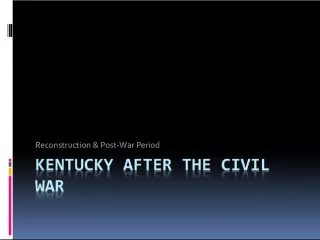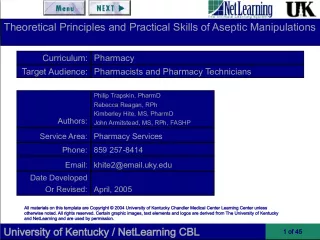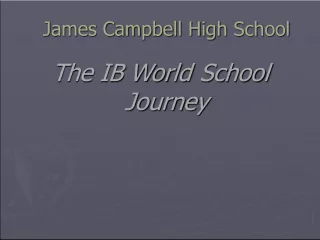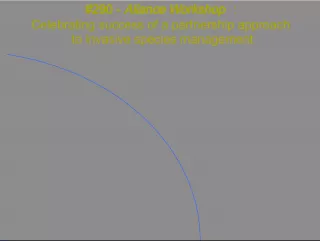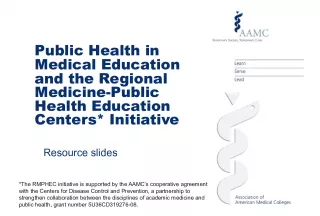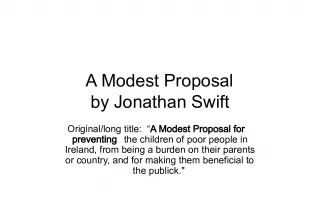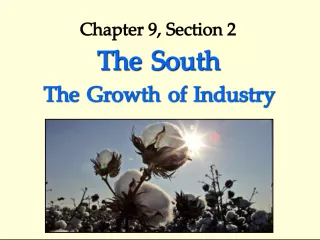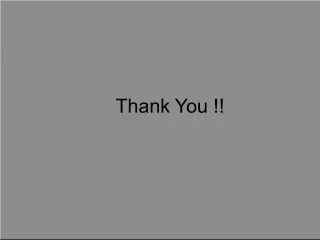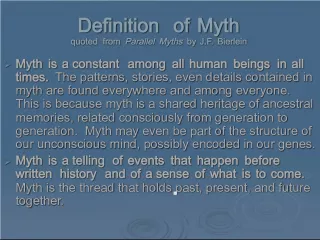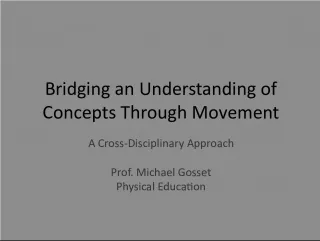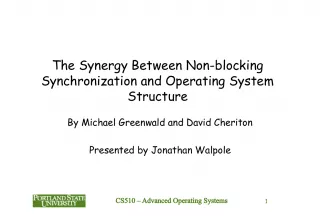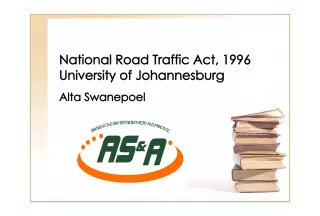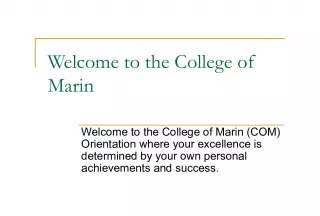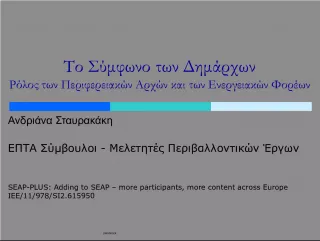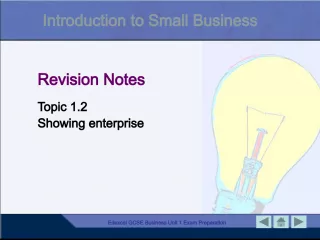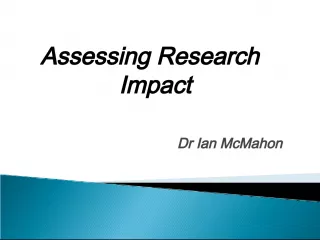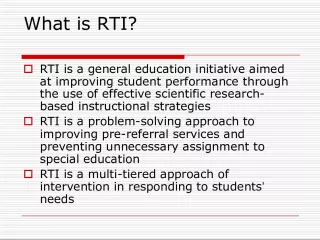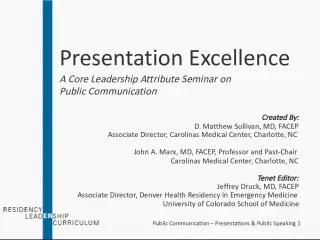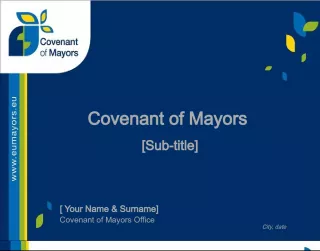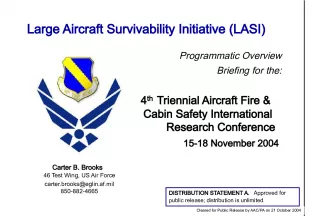Bridging the Excellence Gap: The Kentucky Initiative Dr. Jonathan A. Plucker
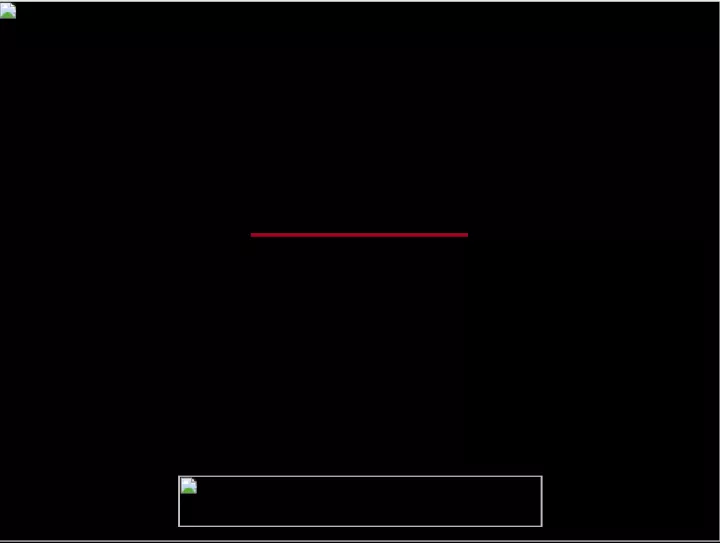

Keynote speech at the 2nd Annual KAGE Conference discussing an initiative to close the excellence gap in Kentucky's education system. Hosted by the Center for Evaluation and Education.
- Uploaded on | 2 Views
-
 masonaddy
masonaddy
About Bridging the Excellence Gap: The Kentucky Initiative Dr. Jonathan A. Plucker
PowerPoint presentation about 'Bridging the Excellence Gap: The Kentucky Initiative Dr. Jonathan A. Plucker'. This presentation describes the topic on Keynote speech at the 2nd Annual KAGE Conference discussing an initiative to close the excellence gap in Kentucky's education system. Hosted by the Center for Evaluation and Education.. The key topics included in this slideshow are . Download this presentation absolutely free.
Presentation Transcript
1. The Kentucky Excellence Gap Dr. Jonathan A. Plucker 32 nd Annual KAGE Conference February 6, 2012 1
2. 2
3. Center for Evaluation and Education Policy (CEEP) CEEP promotes and supports rigorous program evaluation and nonpartisan policy research primarily, but not exclusively, for education, human service and non-profit organizations. In the area of K-12 education policy, CEEPs mission is to help inform, influence and shape sound policy through effective, nonpartisan research and analysis. For more information about CEEP, go to: http://ceep.indiana.edu 3
4. What is the Excellence Gap? There has been a lot of focus on minimum competency achievement gaps the overall average gaps at low to medium levels of performance between demographic groups Comparatively little attention to gaps in performance among high ability students In a good educational system we should see both equity AND excellence Plenty of evidence this can happen 4
5. Super Awesome Quote! Education systems that fail to develop the potential of students from every background can make claims to neither excellence nor equity, neither quality nor equality. 5
6. Why Should We Care? Life prospects of students from disadvantaged backgrounds Equity of the Educational System Shouldnt there be roughly the same percentage of high-performing students from every background? Is minimum competency really enough? International Competitiveness 6
7. A Widening Excellence Gap TIMSS may be a better international assessment on which to base policy, since it samples by grade and not age and is similar in many ways to NAEP. Both in absolute and relative terms, it is clear the U.S. is at a huge disadvantage. 45%! Not 45%!
8. Measuring the Excellence Gap Percent Scoring at the Highest Level For example Free and Reduced Lunch (FARM) : 6% Advanced Non-Free and Reduced Lunch (Non-FARM) : 15% Advanced 15% - 6% = Excellence Gap of 9% Can also measure using scores at a given high percentile, say the student at the 90th percentile (better for statistical reasons when tracking trends) 8
9. Excellence Gaps Using the NAEP The National Assessment of Educational Progress (NAEP) scored on a 0-500 point scale Roughly every two years by the U.S. Department of Education Performance Levels are Determined by Cut-Scores (Basic, Proficient, Advanced) Math Grade 4: 282 Math Grade 8: 333 Reading Grade 4: 268 Reading Grade 8: 323 9
10. 2009 NAEP Math Results In both Grade 4 and 8, a much smaller percentage of low- income, minority, and English- Language learner students score at the Advanced level on the NAEP 10
11. 2009 NAEP Reading Results There are also large excellence gaps in Reading for FARM, Black, Hispanic, and ELL students 11
12. Summary of 2009 NAEP There are large gaps in the advanced achievement of under- represented groups relative to their peers on multiple assessments Race/Ethnicity Socioeconomic Status English Language Learners These populations are growing as a share of all students These high potential students cannot take care of themselves. 12
13. TRENDS 13
14. % Advanced in Math Grade 4 14 NCLB
15. % Advanced in Reading Grade 8 15 NCLB
16. Trends in Reading Grade 4 at the 90 th Percentile 28.2 24.4 20.6 23.0
17. Long-Term Trends in the Excellence Gap If we go back before the passage of NCLB, there isnt much evidence that the gaps are shrinking many have become much larger. In 2009 and 2011 the numbers for ELL students were especially discouraging, giving back most if not all previous gains over the last dozen years. 17
18. NAEP Math Grade 4 Gap Trends 18 Roughly 2-3 grade levels.
19. NAEP Math Grade 8 Gap Trends 19
20. NAEP Reading Grade 4 Gap Trends 20
21. NAEP Reading Grade 8 Gap Trends 21
22. Worse Than It Looks In many cases there has been very little change in overall performance Some gaps have shrunk because white or non-FARM scores have declined At the present rate, it would take decades (if ever) for the gaps to close. 22
23. Projected Trends in Reading Grade 4 2051 2060
24. More Evidence for the Excellence Gap 24 Not underrepresented?
25. BUT THEY KEEP TELLING US THERES A RISING TIDE 25
26. A Distinct Problem The Excellence Gap is not the same phenomenon as the achievement gap Although achievement gaps are somewhat larger than excellence gaps, there are also closing more quickly and consistently This is especially true for lower-income students during the NCLB era (not that wed call the rate achievement gaps are closing fast ) 26
27. Achievement vs. Excellence Gaps, FARM students 2003-2009 27 Rising tide?
28. A Complicated Story Focusing on race or income in isolation can give a misleading picture Interaction of race & income Changes in composition For example the decline in Reading Grade 8 scores among White and FARM students since 2003 is almost entirely due to lower scores among lower-income Whites. 28
29. Reading G8 90 th Percentile Trends 29 Poor white students performing at similar levels to not-poor Hispanic and Black students ( )
30. SO ITS ALL ABOUT POVERTY THEN? 30
31. NAEP Grade 4 Reading DOD Schools 31
32. WHAT ABOUT KENTUCKY? 32
33. Similar to Other States Kentucky has substantial achievement gaps among advanced students and generally poor performance in Reading Grade 8 and Math Grades 4 & 8 Math appears to be a particular problem area, both for excellence gaps and overall advanced performance 33
34. KY NAEP Percent Advanced in Math Grade 4 - 2011 34
35. U.S. vs. Kentucky Standards for Advanced Kentucky has lower standards for qualifying as an advanced level of achievement. A good example is Math Grade 4 35
36. KY State Test vs. KY NAEP Percent Advanced Grade 4 Math - 2011 36
37. WHY SHOULD YOU CARE? 37
38. The excellence underclass will soon be the majority of students in most states It already is in many states. A culture that values talent in all students is of unestimable benefit to everyone . 38
39. BUT WHAT CAN WE DO ABOUT IT? 39
40. What is the Federal Government Doing? 40
41. What are States Doing? Although some states have adopted a mandate to identify and serve gifted students and have appropriated money to do so: Gifted education funds are very vulnerable due to the fiscal climate Most gifted education funding and policy is still carried out at the state level, with a major effect on equity There is no evidence that ANY state has figured out a way to address Excellence Gaps, and many states have laughably low criteria for what constitutes an Advanced student 41
42. % Advanced Math Grade 4 State vs. NAEP 42
43. Recommendation #1 Make Closing the Excellence Gap a State and National Priority Expose people to the data That which is not visible is by definition invisible. Stop pretending the U.S. is post-racial or beyond class distinctions Much criticism of G/T programs is deserved. 43
44. Recommendation #2 Policymakers and educators should ask two questions: How will this impact advanced students? How will this help more students perform at advanced levels? 44
45. Recommendations #3 and #4 Acknowledge That Both Minimum Competency and Excellence Can be Addressed At the Same Time Other countries acknowledge this, why cant we? Set Realistic Goal to Shrink Gaps Were not getting every subgroup to 10% advanced in every content area any time soon. 45
46. Recommendations #5 and #6 Determine the Appropriate Mix of Federal, State, Local Policies and Interventions Federal mandate probably not a good thing Federal research role probably a very good thing Use things that we know work well Grouping, acceleration, identification PD 46
47. Recommendations #7, #8, and #9 Include the Performance of Advanced Students in Discussions of Common Standards Address the Low-Hanging Policy Fruit Immediately Early graduation and financial aid Conduct More Research on Advanced Learning and Talent Development How to address stereotype threat? 47
48. Future Excellence Gap Work Second edition of report around February 2012 Special report on science excellence gaps in near future Special report on the experiences of gifted black males around August 2012 Report on NAEP excellence gaps in major urban areas around this time next year. 48
49. Excessively Provocative Closing Thought There is no natural advocacy group for advanced students. 49 Congressional aide example.
50. ceep.indiana.edu/mindthegap 50
51. CEEP Contact Information: Jonathan Plucker, Ph.D. Director 1900 East Tenth Street Bloomington, Indiana 47406-7512 812-855-4438 Fax: 812-856-5890 jplucker@indiana.edu http://ceep.indiana.edu 51
